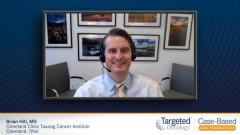
Role of CAR T-cell Therapy in Mantle Cell Lymphoma
Brian Hill, MD, reviews the role of CAR T-cell therapy in mantle cell lymphoma.
Episodes in this series

Brian Hill, MD: Now that CAR [chimeric antigen receptor] T-cell therapy has been FDA approved for relapsed/refractory mantle cell patients, we anticipate that the use will increase significantly over time because patients tend to cycle through therapies.
For frontline treatment, the standard of care will continue for the foreseeable future with chemoimmunotherapy, with consolidation autologous stem cell transplant, and then followed by maintenance rituximab. In the case of second-line treatment, typically patients are still going to be given BTK [Bruton tyrosine inhibitors] inhibitors, although the approval of brexucabtagene autoleucel does not require prior BTK treatment for its use.
We will be seeing more patients referred for CAR T-cell therapy, in the case of relapsed mantle cell lymphoma. It is suggested that for younger patients, or even patients in their 60s or 70s who are generally fit and if they are willing or able to be seen at a referral center, that should be done. If not initially for consideration of transplant but certainly at the time of relapse. The timing of application and use of CAR T-cell therapy does need to be coordinated. Unfortunately, there have been cases where patients may be referred too late for CAR T-cell therapy, and it’s difficult to maneuver to get the patients approved for the treatment and have their leukapheresis to have their T cells collected. The treatment paradigm of relapsed mantle cell is going to be impacted going forward by this approval.
The Cleveland Clinic Taussig Cancer Institute participated in the ZUMA-2 study that led to the approval of brexucabtagene autoleucel and treated several patients through the study. Subsequently several patients were treated with this therapy as a standard-of-care commercial treatment. The experiences have been very similar, with similar tolerability, similar sort of profile in terms of cytokine release syndrome, and potential for neurotoxicity. As has been found in other instances, the selection of patients for clinical trials tends to be more favorable than those who often wind up receiving such treatments in real-world or commercial settings.
Patient selection is still going to be an important part of determining which patients are most suitable for CAR T-cell treatment. The most important indicators are going to be performance status. Age is part of that, but certainly you could be older and have excellent performance status. Some patients in their 60s have multiple comorbidities and poor performance status. Patient selection is important, but it’s going to be a little more lenient than what was seen through the ZUMA-2 study.
Transcript edited for clarity.
Case: A 73-Year-Old Male With Mantle Cell Lymphoma
History
- A 73-year-old man was diagnosed with mantle cell lymphoma in 2016
- He was treated with rituximab, dexamethasone, cytarabine + carboplatin followed by autologous stem cell transplant; achieved PR; continued rituximab maintenance therapy
- Ann Arbor stage IV; MIPI score 6.7, high risk
- Late 2019 he experienced clinical relapse and was started on ibrutinib; achieved SD
Currently
- He complains of a 2-month history of loss of appetite and fatigue
- PMH: hyperlipidemia, medically well-controlled
- PE: bilateral clavicular and cervical lymphadenopathy; otherwise unremarkable
- Labs: WBC 11 X 109/L, hemoglobin 9.5 gm/dL, plt 96,000/u, LDH 405 U/I, ANC 3200/mm3
- Lymph node biopsy: IHC; cyclin D1+, CD5 +, CD10+, CD20+, FISH: t (11;14)
- C/A/P CT scan: widespread lymphadenopathy including bilateral clavicular (2.4 cm, 1.5 cm), and inguinal region (4.6 cm)
- PET/CT shows diffuse uptake of 18F-FDG in the clavicular, axillary and inguinal lymph nodes
- Beta-2-microglobulin 4.1 µg/L
- ECOG PS 0
- Treatment was started with fludarabine + cyclophosphamide, followed by a single infusion of CAR T-cell therapy









































